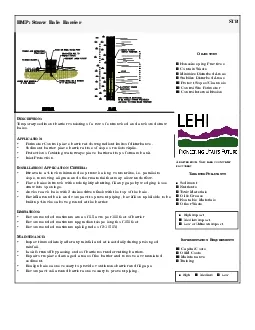

Housekeeping Practices Contain Waste Minimize Disturbed Areas Stabilize Disturbed Areas Protect SlopesChannels Control Site Perimeter Control Internal ErosionTemporary sediment barrier consist ID: 875969
Download Pdf The PPT/PDF document "BMP Straw Bale Barrier" is the property of its rightful owner. Permission is granted to download and print the materials on this web site for personal, non-commercial use only, and to display it on your personal computer provided you do not modify the materials and that you retain all copyright notices contained in the materials. By downloading content from our website, you accept the terms of this agreement.
1 BMP: Straw Bale Barrier Housekeepi
BMP: Straw Bale Barrier Housekeeping Practices Contain Waste Minimize Disturbed Areas Stabilize Disturbed Areas Protect Slopes/Channels Control Site Perimeter Control Internal Erosion Temporary sediment barrier consisting of a row of entrenched and anchored straw bales. Perimeter Control: place barrier at downgradient limits of disturbance. Sediment barrier: place barrier at toe of slope or soil stockpile. Protection of existing waterways: place barrier at top of stream bank. Inlet Protection. Excavate a 4-inch minimum deep trench along contour line, i.e. parallel to slope, removing all grass and other material that may allow underflow. Place bales in trench with ends tightly abutting, fill any gaps by wedging loose straw into openings. Anchor each bale with 2 stakes driven flush with the top of the bale. Backfill around bale and compact to prevent piping, backfill on uphill side to be built up 4-inches above ground at the barrier. Recommended maximum area of 0.5 acre per 100 feet of barrier Recommended maximum upgradient slope length of 150 feet Recommended maximum uphill grade of 2:1 (50%) Inspect immediately after any rainfall and at least daily during prolonged rainfall. Look for runoff bypassing ends of barriers or undercutting barriers. Repair or replace damaged areas of the barrier and remove accumulated sediment. Realign bales as necessary to provide continuous barrier and fill gaps. Recompact soil around barrier as necessary to prevent piping.DAPTED FROM ALT LAKE COUNTY BMP FACT SHEETARGETED OLLUTANTSSedimentNutrientsToxic MaterialsOil & GreaseFloatable MaterialsOther WasteMPLEMENTATION Capital CostsO&M CostsMaintenanceTraining High Impact Medium Impact Low or Unknown Impact Low